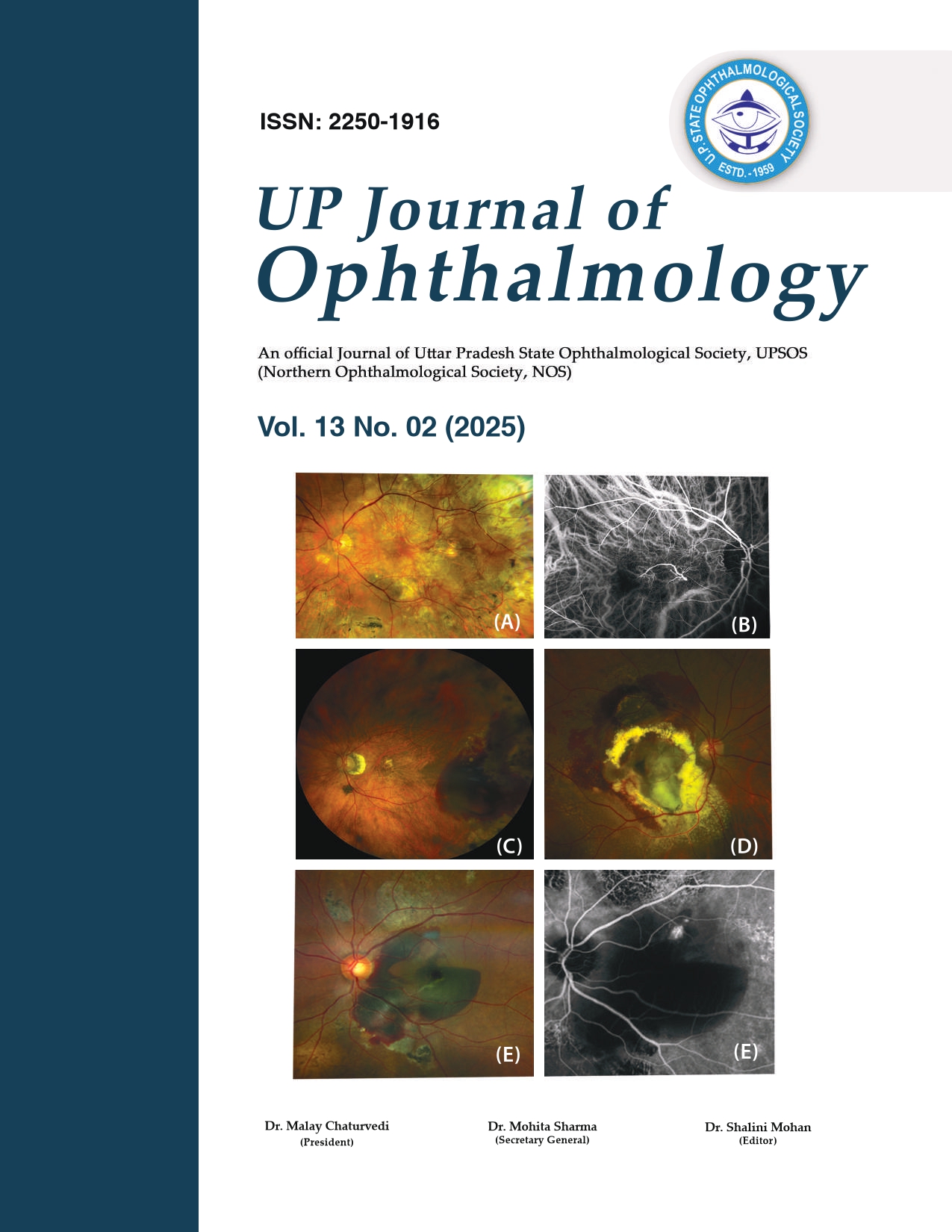Surgically Induced Focal Scleral Necrosis – A Rare Outcome
Downloads
Published
Keywords:
Scleral necrosis, Vitrectomy, Scleral buckling, Epiretinal membrane, Vitreo-retinal surgery, Non-contact tonometry, Right eye, Left eye.Dimensions Badge
Issue
Section
License

This work is licensed under a Creative Commons Attribution 4.0 International License.
© Author, Open Access. This article is licensed under a CC Attribution 4.0 License, which permits use, sharing, adaptation, distribution and reproduction in any medium or format, as long as you give appropriate credit to the original author(s) and the source, provide a link to the Creative Commons licence, and indicate if changes were made. The images or other third party material in this article are included in the article’s Creative Commons licence, unless indicated otherwise in a credit line to the material. If material is not included in the article’s Creative Commons licence and your intended use is not permitted by statutory regulation or exceeds the permitted use, you will need to obtain permission directly from the copyright holder. To view a copy of this licence, visit https://creativecommons.org/licenses/byncsa/4.0/.
Purpose: To present a rare case of surgically induced scleral necrosis (SISN) following vitreoretinal surgery and discuss its clinical presentation, potential etiological factors, and management strategies.Abstract
Methods: A 71-year-old male with a history of hypertension and type 2 diabetes mellitus presented with progressive vision loss in the right eye for six months and ocular discomfort with redness for two months. Two months prior, he had undergone pars plana vitrectomy, scleral buckling, and epiretinal membrane peeling for retinal detachment. Clinical examination revealed reduced visual acuity (1/60 in OD), conjunctival congestion, scleral thinning with uveal exposure, and prominent episcleral vessels. Fundus findings included a pale, tilted optic disc with vessel shifting in the right eye, and hypertensive changes in the left eye. Autoimmune markers (ANA, RA factor) were negative. A diagnosis of post-retinal surgery-induced scleral necrosis was made.
Results: Management included topical fortified vitamin C, antibiotics, corticosteroids, and oral doxycycline. Surgical intervention with scleral patch graft and buckle readjustment was advised. The pathogenesis was attributed to possible scleral ischemia induced by excessive buckle tension or trocar-related trauma, compounded by systemic comorbidities impairing healing.
Conclusion: SISN, though rare, is a serious complication of ocular surgery. Risk factors include multiple surgeries, adjunctive therapies, surgical trauma, and systemic diseases. Early recognition and a multidisciplinary approach are critical for preserving ocular integrity. Surgeons must exercise caution during scleral manipulations and conduct thorough systemic evaluations prior to surgery.
How to Cite
Downloads
Most read articles by the same author(s)
- Naheed Akhtar, Abdul Waris, Intermittent Exotropia- Management In Current Perspective , UP Journal of Ophthalmology: Vol. 8 No. 03 (2020): UP JOURNAL OF OPHTHALMOLOGY
- Naheed Akhtar, Shairin jahan, Abdul Waris, Nada Nadeem Ansari, S.A.R Rizvi, Vitamin K Bleeding Masquerades as Capillary Hemangioma: Case reprt , UP Journal of Ophthalmology: Vol. 4 No. 01 (2016): UP JOURNAL OF OPHTHALMOLOGY
- Rizvi Sa, Abdul Waris, Naheed ., Oxygen therapy in Preterm :Savior or threat ? , UP Journal of Ophthalmology: Vol. 7 No. 03 (2019): UP JOURNAL OF OPHTHALMOLOGY
- Abdul Waris, Naheed Akhtar, Body Building Protein Supplement Leading to Visual impairment , UP Journal of Ophthalmology: Vol. 4 No. 02 (2016): UP JOURNAL OF OPHTHALMOLOGY
- Shaista ., Abdul Waris, Recent Advances in Endophthalmitis: A Review , UP Journal of Ophthalmology: Vol. 11 No. 03 (2023): UP JOURNAL OF OPHTHALMOLOGY
- Raina Garg, Tejal Srivastava, Mohammad Saquib, Surgically Induced Focal Scleral Necrosis – A Rare Outcome , UP Journal of Ophthalmology: Vol. 13 No. 01 (2025): UP Journal of Ophthalmology
Similar Articles
- Raina Garg, Tejal Srivastava, Mohammad Saquib, Surgically Induced Focal Scleral Necrosis – A Rare Outcome , UP Journal of Ophthalmology: Vol. 13 No. 01 (2025): UP Journal of Ophthalmology
- Suraj Kumar Mishra, Aparajita Chaudhary, Vinod Singh, SP Singh, Anatomical and Functional Outcome of Retinal Detachment Surgery , UP Journal of Ophthalmology: Vol. 10 No. 01 (2022): UP JOURNAL OF OPHTHALMOLOGY
- Yogika Shimer, Shalini Mohan, Combined Hamartoma of Retina and Retinal Pigment Epithelium: A Case Report , UP Journal of Ophthalmology: Vol. 12 No. 02 (2024): UP Journal of Ophthalmology
- Swati Singh, Harsh Kumar, Harish H S, Surbi Taneja, Management of Late Onset Sequential Pseudophakic Malignant Glaucoma: A Case Report and Review of Literature , UP Journal of Ophthalmology: Vol. 11 No. 03 (2023): UP JOURNAL OF OPHTHALMOLOGY
- Sameeksha Agrawal, Ankit Agrawal, Krishna K Agrawal, Vijay K. Agrawal, Dengue Fever Associated Foveolitis , UP Journal of Ophthalmology: Vol. 11 No. 01 (2023): UP JOURNAL OF OPHTHALMOLOGY
- Divya Kesarwani, Eye Banking: An Overview , UP Journal of Ophthalmology: Vol. 12 No. 02 (2024): UP Journal of Ophthalmology
- Satyajit Sinha, Nimmi Rani, Ajit Poddar, Vishal Kishore, M Akbar, Lav Kochgaway, Himanshu Kumar, Abhishek Ranjan, Ashish Shekhar, K L Agarwal, Ajit Kumar Dwivedi Kumar, Jaishree Shekhar, Premium IOLs Selection Criteria, Investigations IOl Models and Residual Correction : An Overview , UP Journal of Ophthalmology: Vol. 8 No. 03 (2020): UP JOURNAL OF OPHTHALMOLOGY
- Sanjiv Kumar Gupta, Mohd Shadab, Deepika Verma, Priya Sharma, Siddharth Agrawal, Case Series of Ocular Injury with Firecracker During Diwali in North India , UP Journal of Ophthalmology: Vol. 10 No. 01 (2022): UP JOURNAL OF OPHTHALMOLOGY
- Suraj Singh, Rizwan A Siddiqui, Subhash C Saroj, Sadhvi Singh, Akansha Yadav, Study of Developing Dry Eye After Cataract Surgery in MGD Patients , UP Journal of Ophthalmology: Vol. 12 No. 01 (2024): UP Journal of Ophthalmology
- R. Gayathri, Aanvi Alakshya, Shalvi, Sanjiv Kumar Gupta, Doctor Google, A Friendly Neighbour, or A Nosy Misleader? , UP Journal of Ophthalmology: Vol. 12 No. 02 (2024): UP Journal of Ophthalmology
You may also start an advanced similarity search for this article.







